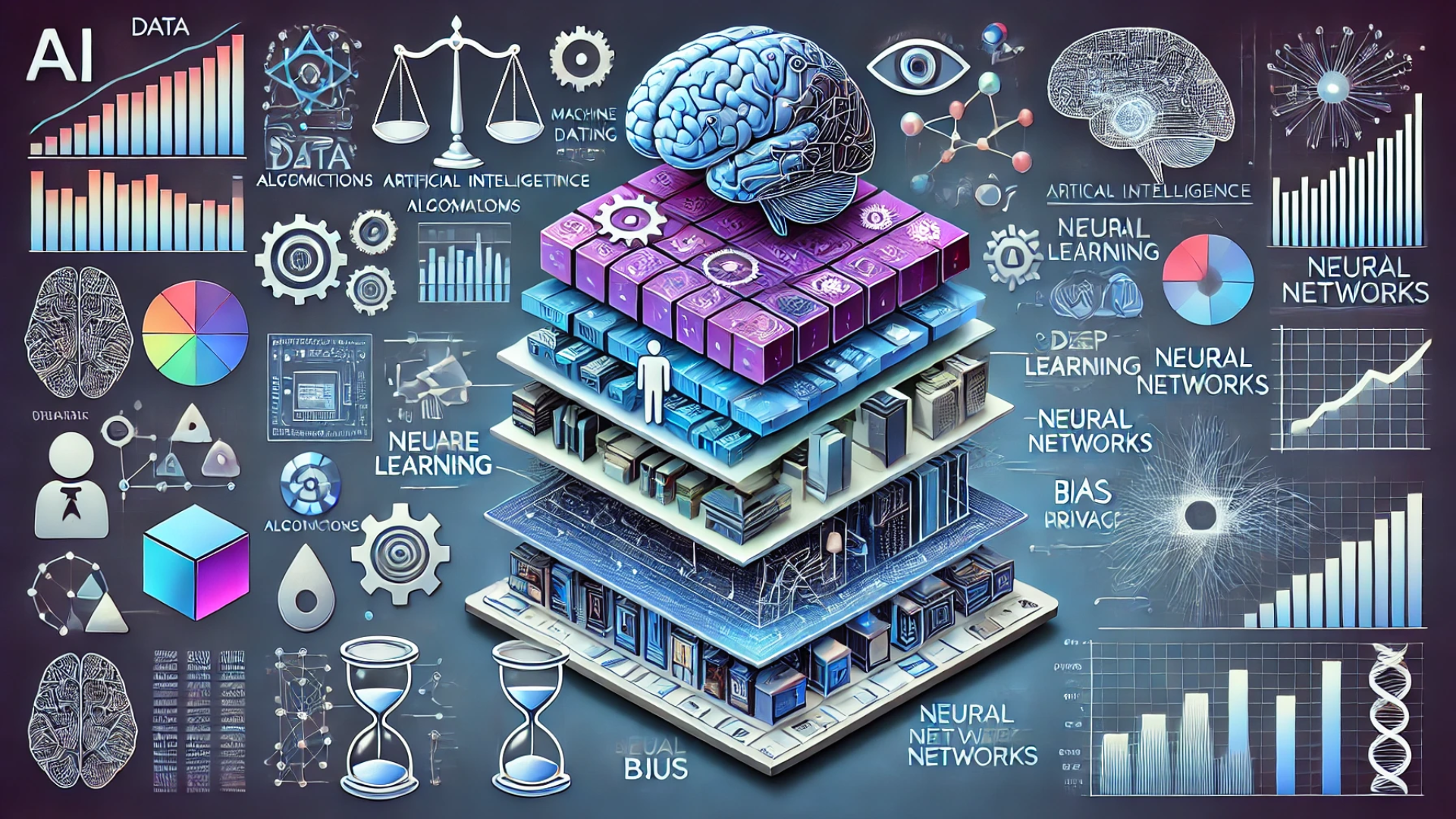
Artificial Intelligence (AI) has become one of the most talked-about topics in recent years, but what exactly goes into creating an AI system? While it might sound like something straight out of a science fiction movie, AI is built on fundamental concepts that are surprisingly easy to understand. Let’s break down the key building blocks of AI in simple terms, so you can see how it all comes together.
1. Data: The Foundation of AI
Think of data as the raw material that powers AI. Without data, AI systems wouldn’t have anything to learn from. Data can come in many forms, like numbers, text, images, or even videos. Every time you use your phone, browse the internet, or even walk down the street with your smartwatch, you’re generating data. This data is collected and used by AI systems to make decisions, recognize patterns, and even predict future outcomes.
Why Is Data So Important?
Data is crucial because it provides the information that AI systems need to “learn.” Just like how humans learn from experience, AI learns from data. The more data an AI system has, the better it can perform. For instance, if you’re teaching an AI to recognize cats in pictures, the more images of cats you provide, the more accurate the AI will become at identifying them.
2. Algorithms: The Brains Behind AI
If data is the fuel, then algorithms are the engine that makes AI work. An algorithm is essentially a set of instructions that tells the AI system how to process the data. In other words, it’s the logic behind how the AI learns and makes decisions.
Types of Algorithms in AI
There are several types of algorithms used in AI, but the most common ones include:
- Supervised Learning Algorithms: These algorithms learn from labeled data. For example, if you give the AI a set of images labeled as “cat” or “dog,” it will learn to distinguish between the two.
- Unsupervised Learning Algorithms: These algorithms work with unlabeled data. The AI tries to find patterns or groupings within the data on its own. Think of it as sorting a pile of mixed objects into similar groups without knowing what the objects are beforehand.
- Reinforcement Learning Algorithms: This type of algorithm learns by trial and error. The AI is rewarded for correct actions and penalized for mistakes, helping it learn the best way to achieve a goal.
3. Machine Learning: Teaching AI to Learn
Machine Learning (ML) is a subset of AI that focuses on giving machines the ability to learn from data without being explicitly programmed. Instead of telling the AI exactly what to do, you provide it with data and let it figure out the best way to accomplish a task.
How Does Machine Learning Work?
Machine Learning relies on algorithms to analyze large amounts of data. The AI system identifies patterns within the data and uses these patterns to make decisions or predictions. For example, a machine learning algorithm can analyze past customer purchases to predict what you might want to buy next.
Machine Learning can be broken down into different categories:
- Supervised Learning: The AI is trained on labeled data and uses this information to make predictions.
- Unsupervised Learning: The AI finds patterns in unlabeled data without human intervention.
- Reinforcement Learning: The AI learns through trial and error, improving over time based on feedback.
4. Neural Networks: Mimicking the Human Brain
Neural Networks are a type of algorithm inspired by the human brain. They are designed to recognize patterns and solve problems in a way that’s similar to how our brains work. Neural networks consist of layers of nodes (or “neurons”) that process data. Each layer of nodes is responsible for a different aspect of the problem-solving process.
What Makes Neural Networks Special?
Neural networks are particularly good at handling complex tasks like image and speech recognition. For example, when you use voice assistants like Siri or Alexa, neural networks are working behind the scenes to understand and respond to your commands. The more data these networks process, the more accurate they become.
5. Deep Learning: Taking AI to the Next Level
Deep Learning is a subset of machine learning that uses neural networks with many layers (hence “deep”). These deep networks can analyze data in greater depth and detail, making them capable of tackling more complex tasks, such as autonomous driving or generating human-like text.
How Does Deep Learning Work?
Deep Learning models process data through multiple layers of neurons, each layer extracting more detailed features of the data. For example, in image recognition, the first layer might identify basic shapes, the next might recognize objects like cars or trees, and the final layer could distinguish between different types of objects. This layered approach allows deep learning models to achieve remarkable accuracy in tasks like image and speech recognition.
6. Natural Language Processing (NLP): Understanding Human Language
Natural Language Processing (NLP) is the branch of AI that focuses on the interaction between computers and humans through language. NLP allows AI systems to understand, interpret, and respond to human language in a way that feels natural.
Common Applications of NLP
NLP is used in a wide range of applications, including:
- Chatbots: Automated systems that can hold conversations with users.
- Speech Recognition: Converting spoken words into text.
- Sentiment Analysis: Determining the emotional tone behind a piece of text.
For example, when you type a question into a search engine, NLP helps the AI understand what you’re asking and provides relevant answers.
7. Ethics in AI: The Responsibility of Building Intelligent Systems
As AI becomes more integrated into our lives, it’s essential to consider the ethical implications. Questions around privacy, bias, and the impact of AI on jobs are just a few of the challenges we face as AI technology advances.
Key Ethical Concerns
- Bias in AI: AI systems can inherit biases from the data they’re trained on. If the data reflects human biases, the AI might make unfair or discriminatory decisions.
- Privacy Issues: As AI systems collect and analyze vast amounts of data, protecting users’ privacy becomes increasingly important.
- Job Displacement: While AI can create new job opportunities, it may also lead to the automation of certain roles, affecting employment in various industries.
It’s crucial for developers, companies, and policymakers to work together to ensure that AI is used responsibly and ethically.
Final Thoughts: The Future of AI
Artificial Intelligence is built on fundamental concepts like data, algorithms, and machine learning. As these building blocks continue to evolve, AI’s potential to change the world grows. From helping doctors diagnose diseases to enabling self-driving cars, the possibilities are endless. By understanding these core components, you’re not just learning about AI—you’re getting a glimpse into the future.
As AI continues to develop, staying informed about its building blocks will help you better understand the technology shaping our world. So, the next time you hear about AI, you’ll know exactly what goes into making these intelligent systems work.
FAQs
1. What is the most important building block of AI?
Data is often considered the most important building block of AI because it provides the information that AI systems need to learn and make decisions.
2. How do algorithms relate to AI?
Algorithms are the instructions or rules that guide how an AI processes data. They are essentially the “brains” behind how AI systems learn and make decisions.
3. What is the difference between Machine Learning and Deep Learning?
Machine Learning is a broader concept where AI systems learn from data. Deep Learning is a subset of Machine Learning that uses neural networks with many layers to analyze data in greater depth.
4. Why is ethics important in AI?
Ethics is crucial in AI to ensure that the technology is used responsibly, fairly, and without causing harm, especially as AI becomes more integrated into our daily lives.
5. What are Neural Networks?
Neural Networks are a type of algorithm inspired by the human brain, designed to recognize patterns and solve complex problems, making them essential for tasks like image and speech recognition.

